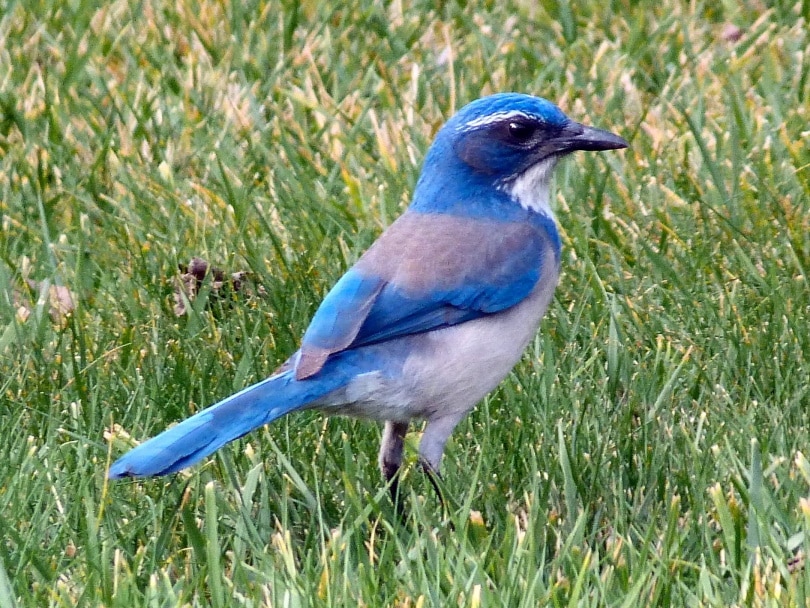5 Proven Ways To Attract Bluebirds To Your Yard & Feeders
Last Updated on

Bluebirds have their own set of preferences for their dream home. Just like a couple needs to make accommodations for each other when looking for the right place to settle down and raise their family, you’ll need to build the right atmosphere and environment to entice a bluebird to share your space.
Bluebirds aren’t the most finicky birds around, but they definitely have their sticking points when it comes to their decision of where to land. Here are the 5 key ways you can attract bluebirds to your yard.
A Little About Bluebirds

In North America there are three types of bluebirds: the western bluebird, the eastern bluebird, and the mountain bluebird. Each of these types lives in a different area based on the season and they are all migratory birds. They are a member of the thrush family and are really quite small.
Eastern and western bluebirds look almost the same, but the throat of a western bluebird is blue while the eastern is a rust color. Male, mountain bluebirds are the most unique in appearance, being almost a solid blue color, and they are also the most skilled at aerial hunting and can catch insects in midair.
Bluebirds eat mostly insects and worms during the warmer months and switch to berries in the wintertime as insects and worms become scarce. They often (but not always) migrate to warmer areas during the winter months and female bluebirds make their mating decisions almost solely on the home that the male has made.
1. Prep the Landscape

Bluebirds tend to prefer taller, more mature trees that are somewhat spaced apart. They stay away from the densely wooded brush where predators might lurk. If you have lots of trees that are close to each other and you’re truly dedicated to getting bluebirds in your yard, then you may want to consider thinning those trees out.
At the same time, dead tree branches can make great perches for bluebirds since there are fewer leaves and other things to obstruct their view. If you’re removing trees you may want to also consider keeping some of the dead tree limbs and branches hanging unless they present a safety hazard.
In addition to the trees, you also want to keep your lawn or ground area well-trimmed. Bluebirds eat insects, worms, and other natural sources of food, and those things are much easier to both see and hunt when the grass is trimmed back. If your yard is more natural, you can still keep it trimmed low and manageable.
2. Remove the Threats

Bluebirds aren’t the toughest fighters in the ecosystem, and they can get hurt, driven off, or killed by a number of different threats that are common in the same areas that bluebirds live in.
The first is cats. Outdoor cats, feral cats, neighbor cats, etc. are all threats to a bluebird that may prevent any from moving in in the first place, and even if they do move in, they could be in danger of attack. If there are cats in your area that you aren’t able to remove, then it may not be the right call to try to lure bluebirds into your yard.
Other birds also pose a significant threat to bluebirds. Sparrows are similar in size to bluebirds and even have the same nesting habits, but they are much more aggressive and will usually outcompete a bluebird for space. If you have sparrows in your yard but you want bluebirds, you’ll need to get rid of the sparrows in some way.
European starlings and wrens are also threats to bluebirds. Starlings won’t fit in a house that’s sized for a bluebird but they will still try to reach inside and eat baby bluebirds. Wrens are even more defensive of their territory than sparrows, and more vicious in their attacks.
3. Build the Housing

In the wild, bluebirds typically house themselves in cavities made by woodpeckers. If a woodpecker has been in your yard and made some holes in trees, those could be prime real estate for a bluebird. If not, you can always build a birdhouse for your bluebirds to move into. You’ll want to make sure the opening is no larger than 1.5 inches and that it is properly roofed to keep the elements out.
If you are building a birdhouse, it’s recommended to have them between four and seven feet off the ground to get the birds high enough to be safe and to have a good vantage point of the area they’ll be doing most of their hunting, but low enough that they can clearly see worms and other food sources on the ground.
A bird feeder is another important part of the housing area. We’ll talk more about food in our fifth tip, but the feeder itself needs to be constructed in a way designed for bluebirds. If the openings to the feeder are too large then other birds may dominate the food. The types of food you’ll want to put in a feeder for a bluebird are different from regular bird seed as they have a completely different diet.
4. Install the Plumbing

The first two tips can be the most difficult. Revamping your landscaping or getting rid of other animals may be too much trouble to justify, but assuming those are both OK, then it gets much easier from there. Buying or building a birdhouse is not usually a big deal, and getting a birdbath is only as difficult as you’re willing to make it.
The ideal bluebird birdbath will be large enough for an entire family of bluebirds to bathe at the same time and be heated so that it can still be used in freezing temperatures. It will also be a fountain or have some bubbling water to more closely simulate the appearance of a small stream to attract the attention of bluebirds more effectively.
But even if that is out of reach, a very simple birdbath can work great as long as you remember to swap out the water every couple of days. A birdbath is an important part of getting bluebirds to live in your yard long-term.
5. Buy the Groceries

The diet of a bluebird is different compared to other birds, and that’s the main reason why using regular birdseed won’t work to attract bluebirds to your area. The bluebird diet consists mostly of insects, berries, and worms, so if you aren’t offering something similar to that you may not have any luck getting bluebirds to your yard.
The most common, effective food birders use to attract and keep bluebirds in their yard is mealworms. Mealworms aren’t technically worms, they’re larvae of darkling beetles (Tenebrionidae) and bluebirds can’t get enough of them. You can raise them on your own or purchase them either live or freeze-dried.
Freeze-dried won’t work as well as live until you train your bluebirds to eat the freeze-dried mealworms by mixing them in with live. After a while, the bluebirds will recognize that the freeze-dried mealworms are good to eat and will do so happily.
If you’re able to find or acquire other insects you can test them out to see if they work, especially after you already have bluebirds nesting in your yard and you want to try to give them a little variety in their diet.
Particularly in the wintertime, bluebirds subsist on berries, so planting berry bushes on your property can be a great way to attract bluebirds.

Conclusion
A bluebird is a fun, beautiful guest or resident to have in your yard, and even though it can take some accommodations to get your yard ready for these beautiful birds, it’s very much be worth the trouble.
Check out some of our top trending bird posts:
- 15 Proven Ways to Attract Cardinals to Your Yard & Feeders
- 10 Proven Ways to Keep Bees OUT of Hummingbird Feeders
- 20 Types of Jaybirds (with Pictures)
Featured Image Credit: Piqsels
About the Author Robert Sparks
Robert’s obsession with all things optical started early in life, when his optician father would bring home prototypes for Robert to play with. Nowadays, Robert is dedicated to helping others find the right optics for their needs. His hobbies include astronomy, astrophysics, and model building. Originally from Newark, NJ, he resides in Santa Fe, New Mexico, where the nighttime skies are filled with glittering stars.
Related Articles:
How to Collimate Binoculars: 9 Expert Tips
How to Clean a Refractor Telescope: Step-by-Step Guide
How to Clean a Telescope Eyepiece: Step-by-Step Guide
How to Clean a Rifle Scope: 8 Expert Tips
When Were Binoculars Invented? History, Today & Future
Can You Use Binoculars to Look At Stars? How to Choose the Right Pair
How to Choose Binoculars for Bird Watching: 10 Expert Tips
Monocular vs Telescope: Differences Explained (With Pictures)

